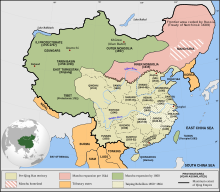This is an old revision of this page, as edited by Horse Eye Jack (talk | contribs) at 19:06, 14 August 2020. The present address (URL) is a permanent link to this revision, which may differ significantly from the current revision.
Revision as of 19:06, 14 August 2020 by Horse Eye Jack (talk | contribs)(diff) ← Previous revision | Latest revision (diff) | Newer revision → (diff)

| This article needs additional citations for verification. Please help improve this article by adding citations to reliable sources. Unsourced material may be challenged and removed. Find sources: "Secession in China" – news · newspapers · books · scholar · JSTOR (July 2020) (Learn how and when to remove this message) |
Secession in China refers to several secessionist movements in the People's Republic of China.
Legal basis
People’s Republic of China
The 1931 constitution of the Chinese Communist Party accepted succession as legal with article 14 stating “The Soviet government of China recognizes the right of self-determination of the national minorities in China, their right to complete separation from China, and to the formation of an independent state for each national minority.” However the CCP’s change from a revolutionary group to the dominant state power in 1949 led to this language being left out of later constitutions and ant legal chance for secession disappeared from Chinese law.
List of secessionist movements in the People's Republic of China
Notes
 Taiwan, a state with limited recognition whose territory is claimed as China's 23rd province, is not included in this list because it has never been governed by the People's Republic of China, the government that was established in mainland China in 1949. For more information, see Political status of Taiwan and Taiwan independence movement.
Taiwan, a state with limited recognition whose territory is claimed as China's 23rd province, is not included in this list because it has never been governed by the People's Republic of China, the government that was established in mainland China in 1949. For more information, see Political status of Taiwan and Taiwan independence movement.
Other
- Guangdong Independence Movement
- Guangdong Republic [zh]
- Fujian People's Government (Fujian People's Government is rather a historical state. The current active movement advocating for Fujian independence is 'Hokkienam' or 'Banvetia' movement.)
- Hunan Independence Movement [zh]
- Yunnan Independence Movement [zh]
- Shanghai Autonomous Movement [zh]
- Federalism in China
Movements

Tibet
Main article: Tibetan independence movementAfter the failed Tibetan uprising, some Tibetans followed the Dalai Lama into India, establishing a government-in-exile called the Central Tibetan Administration.
The movement is no longer supported by the 14th Dalai Lama, who although having advocated it from 1961 to the late 1970s, proposed a sort of high-level autonomy in a speech in Strasbourg in 1988, and has since then restricted his position to either autonomy for the Tibetan people in the Tibet Autonomous Region within China, or extending the area of the autonomy to include parts of neighboring Chinese provinces inhabited by Tibetans.
Xinjiang
Main articles: Xinjiang conflict, Xinjiang re-education camps, and East Turkestan independence movementSeveral armed insurgency groups are fighting the Chinese (PRC) government in Xinjiang, namely the Turkestan Islamic Party and the East Turkestan Liberation Organization, which some people consider to be associated with Al-Qaeda and the Islamic State.
Inner Mongolia
Main article: Inner Mongolian independence movementSouth Mongolian independence is supported by these political parties: the Inner Mongolian People's Party, a member of the Unrepresented Nations and Peoples Organization; the Southern Mongolian Democratic Alliance; and the Mongolian Liberal Union Party.
Related pages
- Ethnic issues in China
- Autonomous regions of China
- Xinjiang conflict
- List of active separatist movements in Asia
- Political status of Taiwan
References
- Hales, Ben. "The Tangled History of the 'Tibet Card'". thediplomat.com. The Diplomat. Retrieved 14 August 2020.
- "Speech of His Holiness the Dalai Lama to the European Parliament, Strasbourg". The Office of His Holiness the Dalai Lama. 14 October 2001. Archived from the original on 25 March 2009. Retrieved 11 April 2009.
- Smith, Warren W. (2008). China's Tibet?: Autonomy or Assimilation. Rowman & Littlefield. p. 214. ISBN 978-0-7425-3989-1.
- McDonald, Hamish (15 March 2005). "Tibet part of China: Dalai Lama". The Age. Fairfax. Retrieved 12 March 2012.
- Reasonable Demands Needed From Dalai Lama
- "Al-Qaeda and Islamic State Take Aim at China. Why have both groups turned their attention to Beijing?". The Diplomat. Archived from the original on 14 March 2017. Retrieved 30 March 2017.
- ""Inner Mongolian People's Party" and the basic facts about its key members". Southern Mongolian Human Rights Information Center. Archived from the original on 25 February 2009. Retrieved 11 April 2009.
- "モンゴル自由連盟党". Archived from the original on 26 July 2010. Retrieved 22 November 2010.(JP)
External links
| Secessions by country | |
|---|---|
| Africa | |
| Asia | |
| Europe | |
| North America | |
| Oceania | |
| South America | |
| Historical | |
| Han Chinese subgroups | |
|---|---|
| Ethnic groups of China | |||||||||||||||||||||||||||||||||||||||||||||||||||
|---|---|---|---|---|---|---|---|---|---|---|---|---|---|---|---|---|---|---|---|---|---|---|---|---|---|---|---|---|---|---|---|---|---|---|---|---|---|---|---|---|---|---|---|---|---|---|---|---|---|---|---|
| Sino-Tibetan |
| ||||||||||||||||||||||||||||||||||||||||||||||||||
| Austroasiatic | |||||||||||||||||||||||||||||||||||||||||||||||||||
| Austronesian | |||||||||||||||||||||||||||||||||||||||||||||||||||
| Hmong-Mien | |||||||||||||||||||||||||||||||||||||||||||||||||||
| Mongolic | |||||||||||||||||||||||||||||||||||||||||||||||||||
| Kra–Dai | |||||||||||||||||||||||||||||||||||||||||||||||||||
| Tungusic | |||||||||||||||||||||||||||||||||||||||||||||||||||
| Turkic | |||||||||||||||||||||||||||||||||||||||||||||||||||
| Indo-European | |||||||||||||||||||||||||||||||||||||||||||||||||||
| Others | |||||||||||||||||||||||||||||||||||||||||||||||||||
| Overseas diaspora |
| ||||||||||||||||||||||||||||||||||||||||||||||||||
| Related | |||||||||||||||||||||||||||||||||||||||||||||||||||
| Immigrants and expatriates |
| ||||||||||||||||||||||||||||||||||||||||||||||||||
| Underlined: the 56 officially recognised ethnic groups ranked by population in their language families according to 2020 census | |||||||||||||||||||||||||||||||||||||||||||||||||||